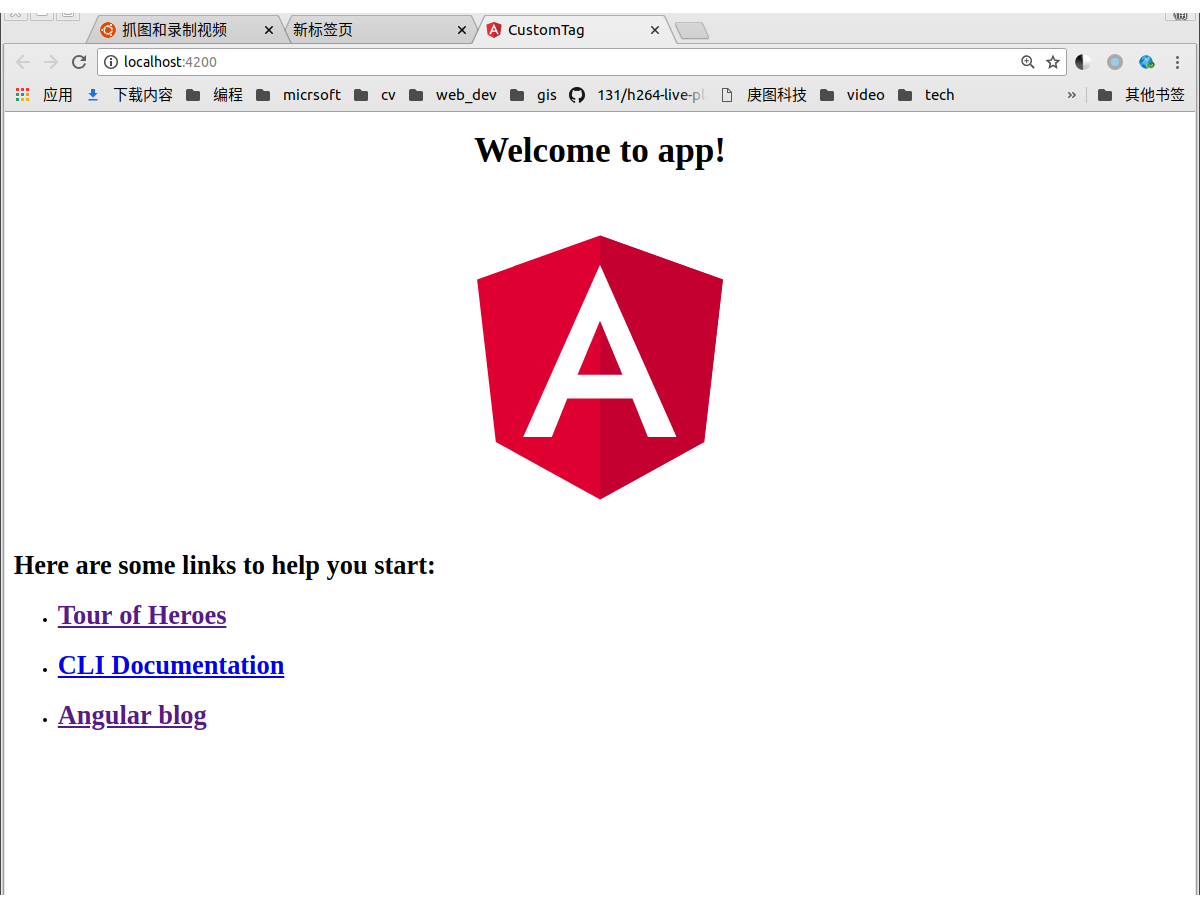这期内容当中小编将会给大家带来有关怎么在Angular6中自定义标签,文章内容丰富且以专业的角度为大家分析和叙述,阅读完这篇文章希望大家可以有所收获。
新建angular工程
通过ng命令新建custom-tag工程
ng new custom-tag
cli新建完相应文件后会通过npm下载所信赖的包,完成后进入目录验证工作空间是否正常。
$cd custom-tag $ng serve --open
--open参数的作用是直接打开浏览器,也可以通过浏览器中直接输入localhost:4200。

增加标签功能
修改app.component.html 内容
<!--The content below is only a placeholder and can be replaced.-->
<!--
<div >
<h2>
Welcome to {{ title }}!
</h2>
<img width="300" alt="Angular Logo" src="data:image/svg+xml;base64,PHN2ZyB4bWxucz0iaHR0cDovL3d3dy53My5vcmcvMjAwMC9zdmciIHZpZXdCb3g9IjAgMCAyNTAgMjUwIj4KICAgIDxwYXRoIGZpbGw9IiNERDAwMzEiIGQ9Ik0xMjUgMzBMMzEuOSA2My4ybDE0LjIgMTIzLjFMMTI1IDIzMGw3OC45LTQzLjcgMTQuMi0xMjMuMXoiIC8+CiAgICA8cGF0aCBmaWxsPSIjQzMwMDJGIiBkPSJNMTI1IDMwdjIyLjItLjFWMjMwbDc4LjktNDMuNyAxNC4yLTEyMy4xTDEyNSAzMHoiIC8+CiAgICA8cGF0aCAgZmlsbD0iI0ZGRkZGRiIgZD0iTTEyNSA1Mi4xTDY2LjggMTgyLjZoMjEuN2wxMS43LTI5LjJoNDkuNGwxMS43IDI5LjJIMTgzTDEyNSA1Mi4xem0xNyA4My4zaC0zNGwxNy00MC45IDE3IDQwLjl6IiAvPgogIDwvc3ZnPg==">
</div>
<h3>Here are some links to help you start: </h3>
<ul>
<li>
<h3><a target="_blank" rel="noopener" href="https://angular.io/tutorial" rel="external nofollow" >Tour of Heroes</a></h3>
</li>
<li>
<h3><a target="_blank" rel="noopener" href="https://github.com/angular/angular-cli/wiki" rel="external nofollow" >CLI Documentation</a></h3>
</li>
<li>
<h3><a target="_blank" rel="noopener" href="https://blog.angular.io/" rel="external nofollow" >Angular blog</a></h3>
</li>
</ul>
-->
<input #inputtext type="text" placeholder="条目">
<input type="button" value="增加" (click)="addItem(inputtext.value)">
<ul>
<li *ngFor="let item of items">{{item}}</li>
</ul>为对应的类增加 addItem()方法,向类中的条目集合(items)增加用户输入的一个条目。
import { Component } from '@angular/core';
@Component({
selector: 'app-root',
templateUrl: './app.component.html',
styleUrls: ['./app.component.css']
})
export class AppComponent {
addItem(item:string){
console.log(`${item} to be added!`);
this.items.push(item);
}
items:string[] =[];
}小结
到目前为止这是一个普通的angular应用,通过增加按钮,要以向列表中增加元素。

应用状态
将完成内容转换为自定义标签
增加@angular/comonents信赖
$ng add @angular/elements
修改app.module.ts
从包中导入相关依赖:
import { Injector} from '@angular/core';
import { createCustomElement } from '@angular/elements';将AppComponent改为动态组件,并通过createCustomElement()注册AppComponent为custom-items
import { BrowserModule } from '@angular/platform-browser';
import { NgModule,Injector } from '@angular/core';
import { createCustomElement } from '@angular/elements';
import { AppComponent } from './app.component';
@NgModule({
declarations: [
AppComponent
],
imports: [
BrowserModule
],
providers: [],
//bootstrap: [AppComponent]
entryComponents : [
AppComponent
]
})
export class AppModule {
constructor(private injector : Injector){
const cust_tag = createCustomElement(AppComponent, {injector : this.injector});
customElements.define('custom-items',cust_tag);
}
ngDoBootstrap() {}
}修改index.html页面
<!doctype html> <html lang="en"> <head> <meta charset="utf-8"> <title>CustomTag</title> <base href="/" rel="external nofollow" > <meta name="viewport" content="width=device-width, initial-scale=1"> <link rel="icon" type="image/x-icon" href="favicon.ico" rel="external nofollow" > </head> <body> <!--<app-root></app-root>--> <custom-items></custom-items> </body> </html>
页面重新出现在浏览器中了,功能也同先前一模一样。
由于浏览器版本的原因可能会出现下面错误,无法创建自定义标签
elements.js:384 Uncaught TypeError: Failed to construct 'HTMLElement': Please use the 'new' operator, this DOM object constructor cannot be called as a function.
at NgElementImpl.NgElement [as constructor] (elements.js:384)
at new NgElementImpl (elements.js:420)
at new AppModule (app.module.ts:24)
at _createClass (core.js:8421)
at _createProviderInstance (core.js:8393)
at initNgModule (core.js:8326)
at new NgModuleRef_ (core.js:9052)
at createNgModuleRef (core.js:9041)
at Object.debugCreateNgModuleRef [as createNgModuleRef] (core.js:10866)
at NgModuleFactory_.push../node_modules/@angular/core/fesm5/core.js.NgModuleFactory_.create (core.js:11583)
可以通过修改tsconfig.json中的构建目标至es6解决该问题
{
"compileOnSave": false,
"compilerOptions": {
"baseUrl": "./",
"outDir": "./dist/out-tsc",
"sourceMap": true,
"declaration": false,
"moduleResolution": "node",
"emitDecoratorMetadata": true,
"experimentalDecorators": true,
"target": "es6",
"typeRoots": [
"node_modules/@types"
],
"lib": [
"es2017",
"dom"
]
}
}增加外部事件
通过output 可以为自定义标签增加自定义事件
import { Component,Output, EventEmitter } from '@angular/core';
@Component({
selector: 'app-root',
templateUrl: './app.component.html',
styleUrls: ['./app.component.css']
})
export class AppComponent {
@Output() itemAdded:EventEmitter<string> = new EventEmitter<string>();
addItem(item:string){
console.log(`${item} to be added!`);
this.items.push(item);
// 向外发送自定义事件
this.itemAdded.emit(item);
}
items:string[] =[];
}在客户端页面可以通过自定义标签对象的addEventListener()方法增加自定义事件响应,通过 event.detail可以获取到angular内部发送的内容
<script>
var items = document.querySelector('custom-items');
items.addEventListener('itemAdded', (event) => {
console.log(event);
})
</script>完结与发布
在package.json中增加发布脚本
"scripts": {
"ng": "ng",
"start": "ng serve",
"build": "ng build --prod --output-hashing none",
"test": "ng test",
"lint": "ng lint",
"e2e": "ng e2e"
},通过npm run build 执行构建,由于我们关闭了文件名hash,得到的输出目录内容如下:
liunan@liunan-desktop:~/webDev/custom-tag$ ls ./dist/custom-tag/ 3rdpartylicenses.txt favicon.ico index.html main.js polyfills.js runtime.js scripts.js styles.css
我们可以看到输出的index.html文件中采用如下方式引用了定义标签的输出,如果其他用户使用会非常不便,
<script type="text/javascript" src="runtime.js"></script> <script type="text/javascript" src="polyfills.js"></script> <script type="text/javascript" src="scripts.js"></script> <script type="text/javascript" src="main.js"></script>
我们可以通过使用cat命令将这些文件按照上面顺序合并成一个文件
$cat runtime.js polyfills.js scripts.js main.js > custom-items.js
上述就是小编为大家分享的怎么在Angular6中自定义标签了,如果刚好有类似的疑惑,不妨参照上述分析进行理解。如果想知道更多相关知识,欢迎关注亿速云行业资讯频道。
免责声明:本站发布的内容(图片、视频和文字)以原创、转载和分享为主,文章观点不代表本网站立场,如果涉及侵权请联系站长邮箱:is@yisu.com进行举报,并提供相关证据,一经查实,将立刻删除涉嫌侵权内容。